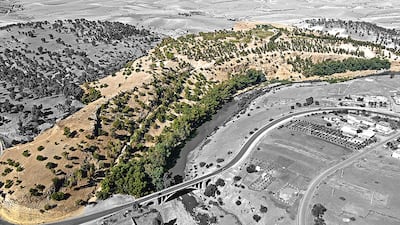Read in
Prehistoric farming society discovered in Morocco rewrites history.
Doha – A remarkable archaeological discovery in Morocco is shedding new light on the prehistory of North Africa and its place in the ancient Mediterranean world.
The Oued Beht Archaeological Project (OBAP), a collaborative effort by researchers from the UK, Italy, and Morocco, has uncovered evidence of a sophisticated farming society that flourished in the region between 3,400 and 2,900 BC.
The site, located on a ridge overlooking the Oued Beht river, was first identified in the 1930s due to an abundance of prehistoric stone artifacts.
However, it was not until 2021 that the OBAP team, led by Professors Cyprian Broodbank (University of Cambridge), Giulio Lucarini (National Research Council of Italy), and Youssef Bokbot (Institut National des Sciences de l’Archéologie et du Patrimoine, Morocco), began intensive excavations.
Radiocarbon dating of charcoal and seeds from the site consistently points to a thriving settlement during the late fourth to early third millennium BC. This period, which the researchers call the “Final Neolithic,” has until now been one of the least understood chapters in the region’s prehistory.
Intensive surface surveys using cutting-edge techniques like drone-based photogrammetry and geophysical prospection revealed the vast scale of the ancient settlement, indicating the main area of activity covered 9-10 hectares.
“The concentration of pottery and lithics at Oued Beht is of a size unprecedented at this date on the African continent outside the Nile corridor and its immediate vicinity,” the authors write in the journal “Antiquity.”
Excavations uncovered numerous deep, bell-shaped pits, with an estimated density of one per 10 square meters across the site.
The team believes these pits, with their constricted openings, may have been used for large-scale grain storage, a hypothesis supported by the discovery of charred remains of domesticated crops like barley, wheat, and peas.
Faunal remains at the site paint a picture of a community heavily reliant on domesticated sheep, goats, cattle, and pigs, with few signs of wild resource exploitation.
As researchers explain, “The untapped potential of Maghrebian later prehistory is exemplified within this one modestly sized pit [Pit 222], which has alone produced the most reliable evidence for agriculture in the region for almost two millennia on either side of the site’s late-fourth-millennium floruit.”
The rich material culture at Oued Beht, including finely made pottery, stone tools, grinding implements, and polished stone axes/adzes, further attests to the sophistication of this ancient society.
One of the most intriguing finds is a tradition of dark-on-light painted pottery, which is rare in the region but has striking parallels to contemporaneous ceramics in southern Iberia.
They also note it is “crucial to consider Oued Beht within a wider co-evolving and connective framework embracing peoples both sides of the Mediterranean-Atlantic gateway during the later fourth and third millennia BC—and, for all the likelihood of movement in both directions, to recognise it as a distinctively African-based community that contributed substantially to the shaping of that social world.”
The discoveries at Oued Beht are just the beginning of a new chapter in the understanding of ancient North African societies and their place in the prehistoric Mediterranean world. As the OBAP team continues their investigations, they aim to shed further light on the emergence, decline, and broader context of this remarkable site.
According to Cyprian Broodbank, the discoveries prove the Maghreb played a crucial role in the later prehistoric Mediterranean that has long gone unrecognized.
“For over 30 years I have been convinced that Mediterranean archaeology has been missing something fundamental in later prehistoric North Africa,” he stated. “Now, at last, we know that was right, and we can begin to think in new ways that acknowledge the dynamic contribution of Africans to the emergence and interactions of early Mediterranean societies.”
Summing up the significance of the findings, the team says: “Oued Beht and the north-west Maghreb will henceforth occupy an integral and…profoundly revisionary place in the later prehistory of the Mediterranean and Africa that they so richly deserve, and that for far too many years has gone unrecognised.”



